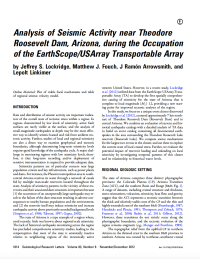Rate and distribution of seismic activity are important indicators of the overall state of tectonic stress within a region. In regions characterized by low levels of seismicity, active fault surfaces are rarely visible at the surface, and the analysis of small-magnitude earthquakes at depth may be the most effective way to identify seismic hazard and risk from ambient tectonic activity. Further, studies of local and regional seismicity are also a direct way to examine geophysical and tectonic boundaries, although determining long-term seismicity levels requires good knowledge of the earthquake cycle. A major challenge in monitoring regions with low seismicity levels, therefore, is that long-term recording and/or deployment of sensitive instrumentation is required to provide adequate data.
Lockridge, J.S., Fouch, M.J., Arrowsmith, J.R., and Linkimer, L., 2012, Analysis of seismic activity near Theodore Roosevelt Dam, Arizona, during the Occupation of the EarthScope/USArray Transportable Array: Bulletin of the Seismological Society of America, v. 83, p. 1014-1022.


